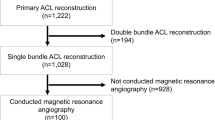Abstract
The purpose of this study is to evaluate the vascular status of autogenous semitendinosus grafts after anterior cruciate ligament reconstruction in humans using magnetic resonance angiography. Twelve patients (mean age, 24.3 years) who underwent anterior cruciate ligament reconstruction with the 4-strand semitendinosus tendon were studied. All patients underwent contrast-enhanced magnetic resonance angiography and second-look arthroscopy in their reconstructed knees on an average of 15.8 months (range 9–22 months) after surgery. Blood vessels to the graft were visualised and contrast medium enhancement for visualising the femoral tunnel, graft, and tibial tunnel was evaluated. Magnetic resonance angiography showed that a branch of the middle genicular artery extended to the upper side of the graft through the posterior capsule and that branches of the inferior genicular artery ended at the lower side of the graft in all patients. These were consistent with the actual findings of the second-look arthroscopy. We found contrast medium enhancement in the femoral and tibial tunnels in all patients. The effect of enhancement at 9 months after ACL reconstruction was higher than that at 22 months. The graft showed enhancement patterns in the posterior portion of the femoral side and the anterior portion of the tibial side. This study demonstrated that the branches of the middle and inferior genicular arteries provide blood supply to the graft, which may influence the maturation of the graft. The revascularisation of the bone tunnels could play an important role in the healing of the ligament–bone tunnel junction.




Similar content being viewed by others
References
Finsterbush A, Frankl U, Matan Y et al (1990) Secondary damage to the knee after isolated injury of the anterior cruciate ligament. Am J Sports Med 18:475–479
Fujikawa K, Seedhom BB, Matsumoto H, Kawakubo M, Otani T (1993) The Leeds–Keio ligament. In: Stover AE (ed) Intraarticular reconstruction of the anterior cruciate ligament. Butterworth-Heinemann, Oxford, pp 173–207
Hara K, Kubo T, Shimizu C, Suginoshita T, Minami G, Hirasawa Y (1999) A new arthroscopic method for reconstructing the anterior and posterior cruciate ligaments using a single-incision technique: simultaneous grafting of the autogenous semitendinosus and patellar tendons. Arthroscopy 15:871–876
Kannus P, Jarvinen M (1987) Conservatively treated tears of the anterior cruciate ligament. J Bone Joint Surg Am 69:1007–1012
Kohn D (1986) Arthroscopy in acute injuries of anterior cruciate-deficient knees: fresh and old intraarticular lesions. Arthroscopy 2:98–102
Noyes FR, Barber-Westin SD (1996) Reconstruction of the anterior cruciate ligament with human allograft. Comparison of early and later results. J Bone Joint Surg Am 78(4):524–537
Rosenberg TD, Deffner KT (1997) ACL reconstruction: semitendinosus tendon is the graft of choice. Orthopaedics 20:396–398
Shelbourne KD, Nitz P (1990) Accelerated rehabilitation after anterior cruciate ligament reconstruction. Am J Sports Med 18(3):292–299
Arnoczky SP, Warren RF, Minei JP (1986) Replacement of the anterior cruciate ligament using a synthetic prosthesis. An evaluation of graft biology in the dog. Am J Sports Med 14(1):1–6
Arnoczky SP, Tarvin GB, Marshall JL (1982) Anterior cruciate ligament replacement using patellar tendon. An evaluation of graft revascularisation in the dog. J Bone Joint Surg Am 64(2):217–224
Clancy WG Jr, Nelson DA, Reider B, Narechania RG (1982) Anterior cruciate ligament reconstruction using one-third of the patellar ligament, augmented by extra-articular tendon transfers. J Bone Joint Surg Am 64(3):352–359
Clancy WG Jr, Narechania RG, Rosenberg TD, Gmeiner JG, Wisnefske DD, Lange TA (1981) Anterior and posterior cruciate ligament reconstruction in rhesus monkeys. J Bone Joint Surg Am 63(8):1270–1284
Unterhauser FN, Bail HJ, Hoher J, Haas NP, Weiler A (2003) Endoligamentous revascularisation of an anterior cruciate ligament graft. Clin Orthop Relat Res 414:276–288
Robert H, Es-Sayeh J, Heymann D, Passuti N, Eloit S, Vaneenoge E (2003) Hamstring insertion site healing after anterior cruciate ligament reconstruction in patients with symptomatic hardware or repeat rupture: a histologic study in 12 patients. Arthroscopy 19(9):948–954
Kawamura S, Ying L, Kim HJ, Dynybil C, Rodeo SA (2005) Macrophages accumulate in the early phase of tendon-bone healing. J Orthop Res 23(6):1425–1432
Dovan TT, Ritty T, Ditsios K, Silva MJ, Kusano N, Gelberman RH (2005) Flexor digitorum profundus tendon to bone tunnel repair: a vascularization and histologic study in canines. J Hand Surg [Am] 30(2):246–257
Kreitner KF, Kalden P, Neufang A, Duber C, Krummenauer F, Kustner E, Laub G, Thelen M (2000) Diabetes and peripheral arterial occlusive disease: prospective comparison of contrast-enhanced three-dimensional MR angiography with conventional digital subtraction angiography. Am J Roentgenol 174(1):171–179
Ho KY, Leiner T, de Haan MW, Kessels AG, Kitslaar PJ, van Engelshoven JM (1998) Peripheral vascular tree stenoses: evaluation with moving-bed infusion-tracking MR angiography. Radiology 206(3):683–692
Scapinelli R (1968) Studies on the vasculature of the human knee joint. Acta Anat 70:305–331
Nakajima H, Kondo M, Kurosawa H, Fukubayashi T (1979) Insufficiency of the anterior cruciate ligament. Review of our 118 cases. Arch Orthop Trauma Surg 95(4):233–40
Goradia VK, Rochat MC, Kida M, Grana WA (2000) Natural history of a hamstring tendon autograft used for anterior cruciate ligament reconstruction in a sheep model. Am J Sports Med 28(1):40–46
Gaffney K, Cookson J, Blades S, Coumbe A, Blake D (1998) Quantitative assessment of the rheumatoid synovial microvascular bed by gadolinium-DTPA enhanced magnetic resonance imaging. Ann Rheum Dis 57(3):152–157
Howell SM, Knox KE, Farley TE, Taylor MA (1995) Revascularisation of a human anterior cruciate ligament graft during the first two years of implantation. Am J Sports Med 23(1):42–49
Author information
Authors and Affiliations
Corresponding author
Rights and permissions
About this article
Cite this article
Arai, Y., Hara, K., Takahashi, T. et al. Evaluation of the vascular status of autogenous hamstring tendon grafts after anterior cruciate ligament reconstruction in humans using magnetic resonance angiography. Knee Surg Sports Traumatol Arthr 16, 342–347 (2008). https://doi.org/10.1007/s00167-007-0478-6
Received:
Accepted:
Published:
Issue Date:
DOI: https://doi.org/10.1007/s00167-007-0478-6




